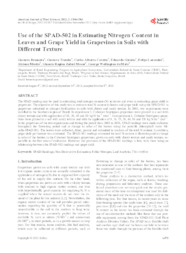Use of the SPAD-502 in estimating nitrogen content in leaves and grape yield in grapevines in soils with different texture.
Use of the SPAD-502 in estimating nitrogen content in leaves and grape yield in grapevines in soils with different texture.
Autoria: BRUNETTO, G.; TRENTIN, G.; CERETTA, C. A.; GIROTTO, E.; LORENSINI, F.; MIOTTO, A.; MOSER, G. R. Z.; MELO, G. W. de
Resumo: The SPAD reading may be used in estimating total nitrogen content (N) in leaves and even in estimating grape yield in grapevines. The objective of this study was to estimate total N content in leaves and grape yield using the SPAD-502 in grapevines submitted to nitrogen fertilization in soils with clayey and sandy texture. In 2008, two experiments were installed in the Southern region of Brazil. In experiment 1, Cabernet Sauvignon grapevines were planted in a soil with clayey texture and with application of 10, 20, 40 and 80 kg·N·ha−1·year−1. In experiment 2, Cabernet Sauvignon grape- vines were planted in a soil with sandy texture and with the application of 0, 10, 15, 20, 40, 80 and 120 kg·N·ha−1·year−1. In the grapevines of the two experiments and during the period from 2008 to 2010, SPAD readings were made on leaves throughout the flowering period and at change in color of the berries using the portable chlorophyll meter Mi- nolta-SPAD-502. The leaves were collected, dried, ground and submitted to analysis of the total N content. In addition, grape yield per hectare was evaluated. The SPAD-502 readings estimated the total N content in flowering and at change in color of the berries in the Cabernet Sauvignon grapevines grown on soils with clayey texture and sandy texture, es- pecially in the first year of evaluation. However, the precision of the SPAD-502 readings is low, with there being no relationship between the SPAD-502 readings and grape yield.
Ano de publicação: 2012
Tipo de publicação: Artigo de periódico
Unidade: Embrapa Pecuária Sul
Palavras-chave: Análise foliar, Estimativa, Nitrogênio, Nutrição vegetal, SPAD-502, Uva, Viticultura
Observações
1 - Por padrão são exibidas publicações dos últimos 20 anos. Para encontrar publicações mais antigas, configure o filtro ano de publicação, colocando o ano a partir do qual você deseja encontrar publicações. O filtro está na coluna da esquerda na busca acima.
2 - Para ler algumas publicações da Embrapa (apenas as que estão em formato ePub), é necessário ter, no celular ou computador, um desses softwares gratuitos. Sistemas Android: Google Play Livros; IOS: iBooks; Windows e Linux: software Calibre.
Acesse outras publicações
Acesse a Base de Dados da Pesquisa Agropecuária (BDPA) para consultar o acervo completo das bibliotecas da Embrapa.

